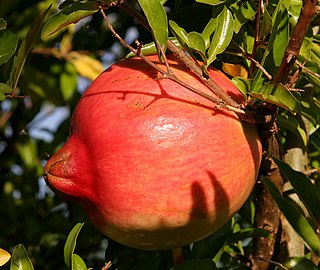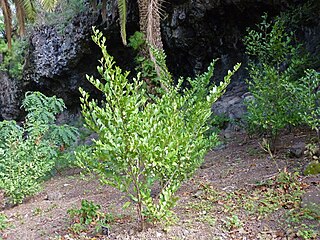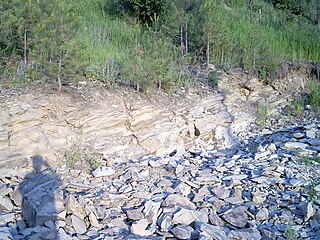
Punica is a small genus of fruit-bearing deciduous shrubs or small trees in the flowering plant family Lythraceae. The better known species is the pomegranate. The other species, the Socotra pomegranate, is endemic to the island of Socotra. It differs in having pink flowers and smaller, less sweet fruit.

Lysimachia is a genus consisting of 193 accepted species of flowering plants traditionally classified in the family Primulaceae. Based on a molecular phylogenetic study it was transferred to the family Myrsinaceae, before this family was later merged into the Primulaceae.

Saururaceae is a plant family comprising four genera and seven species of herbaceous flowering plants native to eastern and southern Asia and North America. The family has been recognised by most taxonomists, and is sometimes known as the "lizard's-tail family". The APG IV system assigned it to the order Piperales in the clade magnoliids.

Ludwigia is a genus of about 82 species of aquatic plants with a cosmopolitan but mainly tropical distribution.

Sparganium (bur-reed) is a genus of flowering plants, described as a genus by Linnaeus in 1753. It is widespread in wet areas in temperate regions of both the Northern and Southern Hemispheres. The plants are perennial marsh plants that can grow to 3.5 m, with epicene flowers.

Lyonia is a genus of flowering plants in the family Ericaceae. There are about 35 species native to Asia and North America.

Visnea is a monotypic genus of flowering plants in family Pentaphylacaceae. The genus contains a single species, Visnea mocanera a tree native to the Canary Islands and Madeira.

Epipremnum is a genus of flowering plants in the family Araceae, found in tropical forests from China, the Himalayas, and Southeast Asia to Australia the western Pacific. They are evergreen perennial vines climbing with the aid of aerial roots. They may be confused with other Monstereae such as Rhaphidophora, Scindapsus and Amydrium.

Lasioideae is a subfamily of flowering plants in the family Araceae. It contains ten living genera: Anaphyllopsis, Anaphyllum, Cyrtosperma, Dracontioides, Dracontium, Lasia, Lasimorpha, Podolasia, Pycnospatha, and Urospatha. The subfamily also includes the extinct genus Keratospema described from Ypresian fossils recovered at the Eocene Okanagan Highlands Princeton Chert site.

Zenobia, called honeycup, is a North American genus of shrubs in the family Ericaceae.

Decodon verticillatus, the sole living species in the genus Decodon, is a flowering plant in the family Lythraceae. It is commonly known as waterwillow or swamp loosestrife. It is native to wetlands in the eastern half of the United States and Canada.

The Princeton Chert is a fossil locality in British Columbia, Canada, which comprises an anatomically preserved flora of Eocene Epoch age, with rich species abundance and diversity. It is located in exposures of the Allenby Formation on the east bank of the Similkameen River, 8.5 km (5.3 mi) south of the town of Princeton, British Columbia.

The Allenby formation is a sedimentary rock formation in British Columbia which was deposited during the Ypresian stage of the Early Eocene. It consists of conglomerates, sandstones with interbedded shales and coal. The shales contain an abundance of insect, fish and plant fossils known from 1877 and onward, while the Princeton Chert was first indented in the 1950's and is known from anatomically preserved plants.

Nuphar carlquistii is an extinct species of flowering plant in the family Nymphaeaceae related to the modern spatterdock, Nuphar advena. The species is known from fossil seeds and fruits found in the early Eocene Okanagan Highlands deposits of northern Washington state and British Columbia, Canada.

Proserpinaca, commonly called mermaidweed, is a genus of flowering plants in the watermilfoil family (Haloragaceae). It is a small genus, comprising only two to three extant species, all of which are native to eastern North America and the West Indies. All species in this genus are found in aquatic or terrestrial wetland habitats.
Hypericum holyi is an extinct species of the genus Hypericum that was present from the Lower Miocene to the Upper Miocene. Fossil seeds of the species have been found in Central Europe in general and Central Jutland, Denmark, in particular.
The paleoflora of the Eocene Okanagan Highlands includes all plant and fungi fossils preserved in the Eocene Okanagan Highlands Lagerstätten. The highlands are a series of Early Eocene geological formations which span an 1,000 km (620 mi) transect of British Columbia, Canada and Washington state, United States and are known for the diverse and detailed plant fossils which represent an upland temperate ecosystem immediately after the Paleocene-Eocene thermal maximum, and before the increased cooling of the middle and late Eocene to Oligocene. The fossiliferous deposits of the region were noted as early as 1873, with small amounts of systematic work happening in the 1880-90s on British Columbian sites, and 1920-30s for Washington sites. A returned focus and more detailed descriptive work on the Okanagan Highlands sites revived in the 1970's. The noted richness of agricultural plant families in Republic and Princeton floras resulted in the term "Eocene orchards" being used for the paleofloras.

The Eocene Okanagan Highlands or Eocene Okanogan Highlands are a series of Early Eocene geological formations which span a 1,000 km (620 mi) transect of British Columbia, Canada, and Washington state, United States. Known for a highly diverse and detailed plant and animal paleobiota the paleolake beds as a whole are considered one of the great Canadian Lagerstätten. The paleobiota represented are of an upland subtropical to temperate ecosystem series immediately after the Paleocene–Eocene thermal maximum, and before the increased cooling of the middle and late Eocene to Oligocene. The fossiliferous deposits of the region were noted as early as 1873, with small amounts of systematic work happening in the 1870–1920s on British Columbian sites, and 1920–1930s for Washington sites. Focus and more detailed descriptive work on the Okanagan Highland sites started in the late 1960s.
The Paleobiota of the Klondike Mountain Formation comprises a diverse suite of Early Eocene plants and animals recovered from North Central Washington State. The formation outcrops in locations across the north western area of Ferry County, with major sites in Republic, north west of Curlew Lake, and on the Toroda Creek area. The formation is the southern most of the Eocene Okanagan Highlands, sharing much of the paleoflora and paleofauna with site across Central and southern British Columbia.
Allenbya is an extinct genus of water lilies in the family Nymphaeaceae containing a single species Allenbya collinsonae. The species is known from permineralized remains recovered from the Early Eocene Princeton Chert in British Columbia, Canada.















